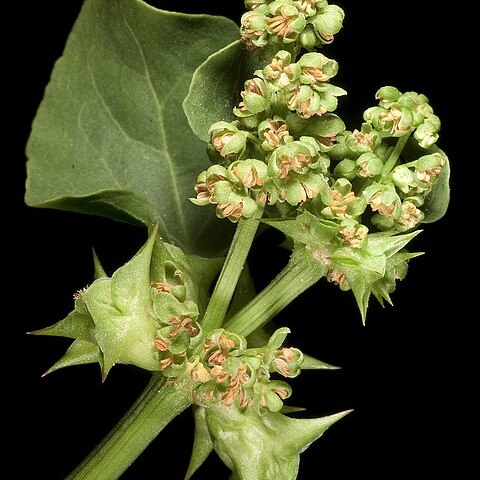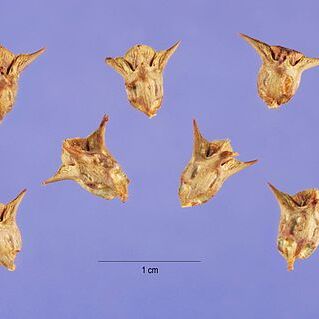Annual herb. Stems prostrate to ascending, often reddish. Petiole = or > lamina except in uppermost lvs, to c. 10 mm long. Lamina 2.5-7 × 1.5-4.5 cm, ovate-oblong to almost oblong, entire; base truncate to subcordate; apex obtuse or subacute; ochreae initially c. 1 cm long. ♂ infl. to c. 3 cm long, much shorter towards branch ends; perianth 1.2-1.8 mm long, green. ♀ fls with perianth subtended by membranous bract; outer segments 2-4 mm long at flowering, with an outward-directed spine c. = segment; inner perianth segments exserted from outer but acuminate tip soft and much < spines. Fr. c. 1 cm long including spines, indurated and rigid; outer segments with 4 deep depressions; inner segments completely enclosing the nut; nut glossy, trigonous, c. 5 mm long.
Plants 1-4(-6) dm. Stems pros-trate, decumbent, or ascending, base often reddish, branched proximally. Leaves: ocrea loose, glabrous; petiole (0.5-)1-8(-15) cm, glabrous; blade subhastate to elliptic or ovate, 1-10 × 0.5-6 cm, base truncate to cuneate, apex obtuse to acute. Staminate flowers 1-8 per ocreate fascicle; tepals narrowly oblong to oblanceolate, 1.5-2 mm. Pistillate flowers 1-4 per ocreate fascicle; outer tepals ovate to oblong, 4-6 mm in fruit, inner tepals broadly triangular-ovate, 5-6 mm in fruit, apex mucronate. Fruiting perianths 7-9 × 9-10 mm, spines ascending or spreading, 5-10 mm, base tapering. Achenes 4-6 × 2-3 mm, shiny. 2n = 20.
Annual, herbaceous weed, 0.15-0.60 m high; monoecious. Leaves petiolate, ovate-oblong; ocrea soon lacerating, deciduous. Flowers in axillary fascicles. Male flowers pedicellate; perianth segments 5 or 6, equal, spreading; stamens 4-6. Female flowers sessile; perianth 6-lobed, enlarged and hardened in fruit; tube ovoid, 3-or 6-angled in fruit and ± transversely ribbed between angles; lobes in 2 series, outer 3 spiny in fruit and inner obtuse or aristate. Ovary 3-angled; styles 3, short; stigmas dilated, fimbriate. Flowering time all year. Fruit a triquetrous nut enclosed within persistent perianth tube. Seed subterete.
Female flowers sessile, urceolate, 6-lobed; lobes 2-seriate, the 3 inner lobes 3 × 2.5 mm, erect, rounded or very broadly ovate, strongly veined, the lateral veins bifurcating near the margin, the midrib prominent and produced into a spiny awn at the tip; outer lobes connate, forming a tube c. 4 mm long, indurated in fruit and produced at the tips into sharp rigid spreading spines c. 4–5 mm long, the faces perforated with 4 large pits; ovary 3–3.5 × 2–2.5 mm, triquetrous; styles 3, very short, 0.8 × 0.4 mm, broadly ovate, fringed on the inner side and lacerated above.
Perennial herb, up to 0.6 m high; monoecious. Stems annual, erect or procumbent, much branched; green or tinged red. Leaves with blade oblong-ovate to ovate, 35-60 x 20-30 mm, base truncate or somewhat cordate, apex obtuse, slightly decurrent. Ocrea lacerate. Flowers: male flowers in terminal and axillary, pedunculate clusters; female flowers sessile in axillary clusters; perianth with spines at tips of outer segments, surface of tube perforated, green to whitish; May-Oct.
A small herb. It is like a dock but the stems trail along the ground. It is an annual plant. The leaves are 3-10 cm long on very long stalks. Male and female flowers are separate. The flowers are 2 mm long. The seed pods are large and spiny. The seed pods are about 1 cm long. They have 3 sharp spines.
Male flowers in terminal and axillary pedunculate clusters; perianth segments 2 × 1 mm, ovate-elliptic, green with brown midribs and veins; stamens ± as long as the perianth; filaments filiform; anthers orange-brownish, 0.7–0.8 × 0.3 mm, ellipsoid-cylindric.
Annual herb, up to 0.6 m high. Flower and fruit (nut) with a terminal spiny arista and outer edge with very sharp, rigid spreading spines. Surface of tube perforated. Flowers green to whitish.
Leaf lamina 3.5–6 × 2–3 cm, oblong-ovate to ovate, rounded or obtuse at the apex, rounded cordate or truncate at the base and ± decurrent on the petiole; petiole 3–10 cm long, channelled.
Monoecious annual, up to 300 mm tall, with sprawling to prostrate branches. Leaves long-petiolate, hastate. Flowers in axillary clusters, greenish. Fruit spiny.
Monoecious annual to 30 cm with sprawling to prostrate branches. Leaves long-petiolate, hastate. Flowers in axillary clusters, greenish. Fruits spiny.
Nut 6 × 12–13 mm (including spines), triquetrous, included within the hardened perianth, very accrescent and with divaricate rigid spines.
Stem green or tinged with red especially towards the base, up to 30 cm or more long, furrowed, glabrous.
An erect or prostrate, much branched herb with a semi-woody rootstock.
Ocrea brown, 5 mm long, membranous, lacerated.
Seeds 3–3.5 × 2.5 mm, triquetrous.


